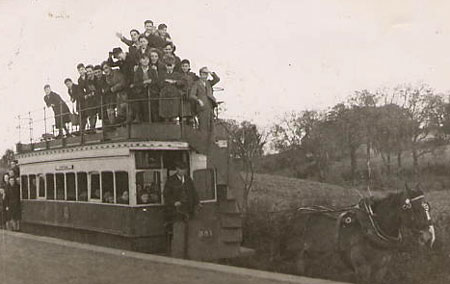|
This article was first published in the Lurgan Mail.
When I began writing press features in the early eighties, I was amazed and encouraged by the feedback.
Almost immediately, I gained the interest and enthusiastic support of a happy band of 'old timers' willing and able to rehearse memories of the latter part of the 19th century.
'The nineteenth century folk' I termed them. Sadly, my dear friends, are no longer with us, but I managed to record a significant column of material for posterity -- mostly in print but some on tape.
In those days, when I alluded to 'the turn of the century' it was 1900. Now the century has turned again so where does one begin?
Since it is a Christian millennium which we have just celebrated, I feel that the words written prior to World War 1 are worth quoting.
I said to a man who stood at the gate of the year: 'Give me a light that I may tread safely into the unknown.'
And he replied ' Go out into the darkness and put your hand into the hand of God that shall be better for you than light and safer than a known way';
So I went forth and finding the hand of God trod gladly into the night.
George V1 made that quotation famous when he used it in his broadcast to the Nation at Christmas 1939, the first war-time Christmas of his reign. And there is food for thought in it at the dawn of this third Christian millennium.
The 19th Century folk are no longer with us but I have vivid memories of happy hours spent in their company and highlights of their reminiscences live on -- benchmarks for future historians.
I will recall how the late John Emerson, founder of the Emerson dynasty in his nineties chuckled as he rehearsed having run across a field as a boy to see a cyclist going down the Ardmore road ' with his feet not moving' - the advent of the free wheel!
All the early bicycles had fixed wheels. In other words, when the road wheels rotated so did the pedals. Experienced riders stood on the pedals to stop, but it was a tricky manoeuvre. I tried it once and very nearly went over the handlebars.
Then I remembered Tom McCrory of Anglagallon (1890-1988). He rehearsed how a doctor came from Broomhedge, say ten miles away 'astride a big wheel the size of a cart wheel' to attend Tom's mother (circa 1840-1928). Tom said he had been about ten, hence the 'penny farthing' vintage bicycle was all the good doctor had for transport around the turn of that particular century, i.e. circa 1900.
My mother, 1873-1960, often talked about the Lurgan Mall Stones. I saw a picture of old Church Place exhibited at Brian Lavery's premises, last week. Beside the hut which once stood on the site of the war memorial the circular mall stones were clearly visible. I asked one or two people what they were but no-one knows. The nearest guess I got was drinking troughs for horses.
The horse trough actually stood opposite the Cosy Corner Café, close to the church railings.
The circular mounds like truncated masonry field piers, were provided as stands for farmers wives to display their baskets of eggs and butter on market days.
The War Memorial displaced the Jubilee fountain, which now stands inside the park gate around 70 years ago. 
A well-laden Irish horse-drawn tram pictured in 1940.
As a student of the William Street Tec. I attended the Armistice Ceremony on 11th November 1929.
Dickie Arnold, vice principal, art teacher and veteran of World War 1, marshalled the entire assembly of Tec boys that day.
That was probably the second year of the Memorial's existence. Incidentally, it was also the year when concrete was laid on all the main thoroughfares of the town replacing the mud and stones of the early streets. Al the gas and water pipes were transferred to the side walks first.
I feel quite bemused now that holes are being dug all over the thoroughfares once more. What will they think of 70 years hence?
The Aghalee bound bus was diverted on one occasion via Windsor Avenue onto the lane-way leading to National Terrace on the Antrim Road from Brownlow. House and the intrepid driver (co-owner) James McSherry shed a window as he passed a wayside tree. I was a schoolboy aboard.
Finally, a memory bequeathed by the late Alfred Pearson who looked after Shankill graveyard between the wars. The grave of James Malcolm is just inside the gate and as a leading citizen (maybe I should say the leading citizen) of the town, he had to have a dressed grave. That is, one carefully lined with moss and flowers wired to the interior walls, plus all the etceteras.
An important cleric with entourage were expected. Alfie whose tied house was close by was concerned that his younger son, a nipper of three should be kept indoors as he was boisterous.
'For my sake Margaret, don't let that boy out till the funeral is over', he beseeched to his spouse.
The lad was shut in with all the doors bolted, but while his mum was watching the funeral arrive the lad got a chair and managed to unbolt the back door which was a mere half a dozen yards from the Malcolm grave.
Seeing his dad standing beside a big man wearing a long white shirt he darted out and grabbed his dad's legs uttering a shrill yo-ho and a whoop.
Alfred told me that at that moment he would liked the earth to have swallowed him . 'Boys will be boys'. I hope the mischievous lad of many years ago won't mind my rehearsal of his childhood exuberance.
| |


